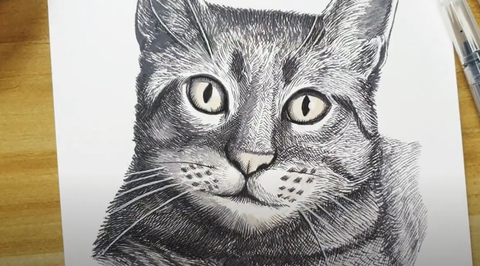How to Paint Succulents: A Step-by-Step Guide to Watercolor Painting Styles
Last Updated: July 1, 2025
Watercoloring is one of the most expressive and fluid painting styles, perfect for capturing the delicate beauty of nature. Among the most charming botanical subjects to paint are succulents—their sculptural forms and muted yet vibrant colors make them ideal for practicing watercolor techniques.

If you're a beginner wondering how to paint succulents or a watercolor enthusiast looking for fresh inspiration, this guide is for you! We’ll walk you through painting succulents using classic watercolor painting techniques, while exploring helpful watercoloring tips and creative styles to elevate your artwork.
Why Paint Succulents?
Why are succulents great for exploring watercolor painting styles? Succulents offer a wide variety of forms, textures, and subtle hues that challenge and refine your watercolor skills. Their symmetrical leaves, waxy surfaces, and vibrant gradients—from cool blues and greens to blush pinks and purples—make them a rich subject for exploration. The best thing about succulents? They are forgiving! Their layered leaves allow you to build up color gradually, and their sturdy shapes are easy to outline and fill. We know you’re excited to learn how to paint succulents so let’s get started!
Discover the A to Z of Painting Styles, Techniques, and Movements
Watercoloring Styles to Explore
Before we dive into the step-by-step process on how to paint succulents, let’s touch on a few watercolor painting styles that you may or may not have tried before.
-
Loose Painting Style – This style emphasizes fluidity and spontaneity and is ideal for backgrounds or expressive pieces. It’s perfect for beginner watercoloring since you can play around with shapes and textures, without focusing on too many specific details.
-
Detailed Realism – This intermediate and advanced watercoloring style focuses on layering color and precise brushwork for lifelike results. It has been around since the Renaissance period and is more accurate, detailed, and photorealistic.
-
Line and Wash – This fun painting style is also called “pen and wash” and combines ink outlines with watercolor washes for a sketchbook feel. You can draw the lines first and add the watercolor wash after, or add the wash first, then draw the lines. This is perfect for beginner watercoloring!
-
Negative Painting – The negative painting style allows you to paint around the subject to define it, rather than painting it directly. First, you draw your subject with a pencil, apply water all over your paper, and then start dropping in pigments. Make sure you choose an open or outline image, as opposed to a detailed one. Once the first layer of watercolor is dry, start applying water to one section around your subject and drop darker pigments until you’re satisfied. Do this all over your paper, avoiding adding water or pigment to your drawn subject.
Tip: Use masking fluid to protect your subject and make sure it won’t get painted over while building colors and layers in the background.
-
Botanical Illustration – This painting style is a precise, scientific approach often used for plant subjects. This is a more advanced watercolor technique used to represent the form, texture, and color of various plants.
Painting succulents lends itself beautifully to both loose and detailed styles, giving you the freedom to experiment and develop your personal artistic approach.

Step-by-Step: How to Paint Succulents in Watercolor
Step 1: Gather Your Materials
Before you start painting your succulents, it’s important to gather your watercolor supplies and tools. If you’re a beginner looking to invest in high-quality watercoloring supplies, read this quick guide on all things watercoloring.
-
Watercolor paper (preferably 140lb or higher)
-
Round brushes (size 4 to 8 are ideal)
-
Eraser
-
A water jar
-
Paper towel or cloth
-
A reference image or real-life succulent arrangement
Step 2: Choose a Composition
The first thing you want to do is to look at your succulent reference—it could be a photo, a plant on your windowsill, or a Pinterest image. Try to imagine it in a setting: perhaps in a spherical glass vase on a sunlit table, casting soft shadows. This visual will guide your composition and add storytelling to your piece. If you’re a watercolor beginner, having a reference image is crucial in guiding your artwork.

Step 3: Sketch Lightly
Using your graphite pencil, sketch the outline of your succulent cluster. Remember, this is just a roadmap for where your paint will go so keep your lines loose and light. You don’t need to “copy” the reference to a T, try to add some customization based on your own unique style.
|
Watercoloring Tip: Avoid hard outlines unless you're using a line-and-wash painting style. Let the paint define the shapes. |

Step 4: Wet-on-Wet for Base Colors
Apply a clean wash of water to a leaf section, then dab in watercolor pigment. Let the paint bloom and blend naturally. Make sure to apply lighter shades first. This is great for creating soft transitions between green, blue, and purple tones typical of succulents.
|
Watercoloring Tip: To add realism and details to your succulent painting, use a color reference. Observe a real succulent - how the light affects its colors and add shadows - or find one on Instagram and Pinterest. |

Step 5: Add Layered Details
Once the first layer is dry, layer on darker tones using the wet-on-dry technique for more defined edges and shadow. This step brings depth and dimension to the leaves. Remember: use light washes to darken the succulent shapes and help you determine the color palette for each succulent.
|
Watercoloring Tip: Always allow layers to dry completely before adding details. Wet layers can mix unintentionally and muddy your colors. |

Step 6: Don’t forget about the mid-tones!
Paint the areas between the highlights and the shadows. Feel free to practice color mixing on a piece of scrap paper if you’re unsure how to achieve the exact tone.
|
Did You Know? You can easily fix a watercoloring mistake using the glazing painting style! This means you can apply color on top of an existing layer. You may also try the lifting painting technique, which allows you to “remove” a color by dabbing with a paper towel or clean cloth. |

Step 7: Paint the Pot and Shadows
Use neutral tones—light browns or soft grays—for the pot. For realistic shadows, use a diluted gray-violet and paint it softly beneath the vase, imagining the light source from one direction.

Step 8: Final Touches
If you opted for succulents inside a spherical glass vase, add highlights by lifting color with a damp brush or tissue. This will give your sphere a more “glass-like” look. For extra detail, use a fine brush to define leaf edges or subtle veins.
|
Watercoloring Tip: Once you’re done, step back and look at your succulent painting from a distance. This will give you a fresh perspective and help you finalize your artwork. |
Expert Tips for Painting Succulents (or Any Greenery)
-
Start Light, Go Dark: With watercolor, you can’t paint light over dark so make sure to build your colors gradually.
-
Mix Your Greens: Avoid flat colors. Mix greens with blues, yellows, or even reds to create natural, organic tones.
-
Use References: Photos or real-life succulents help maintain realism and inspire composition.
-
Practice Shapes: Succulents often follow geometric spirals—practice those curves!
-
Experiment with Textures: Use salt, splattering, or dry brushing to mimic natural textures in plants.
Project Inspiration: Create a Succulent Series
Why stop at one succulent painting? Now that you’re done with your first succulent watercolor painting, try building a mini-series. This will help you hone your skills while building a beautiful collection, try new painting styles and techniques, and have fun!
-
A succulent trio in various pots will allow you to experiment with various shapes, textures, and sizes.
-
Go big or go home! Try watercoloring a full-page watercolor succulent wreath!
-
If you want to practice a detailed realism painting style, try a close-up macro leaf detail study.

Practice Different Watercolor Painting Styles Today!
Watercolor painting is meditation, mindfulness, and play all rolled into one. Painting succulents invites you to appreciate nature’s intricacy while developing your eye and hand. Whether you're exploring loose botanical forms or aiming for photorealistic detail, watercoloring offers endless opportunities to grow as an artist. We hope this blog inspired you to try different watercolor painting styles.
Grab your brush, pick a succulent, and start painting your first succulent art! Share your watercolor succulent paintings with us by using #Altenew. As always, if you’re in need of more easy watercoloring tips and ideas, drop by The Creative Corner. Happy painting!
FAQs About Painting and Watercoloring
Q: What are the main styles of painting?
A: The main styles of painting include realism, impressionism, expressionism, abstract, surrealism, pop art, and minimalism. Each style offers a unique way to express emotion, detail, or visual storytelling.
Q: What are the 7 different types of art?
A: The seven traditional forms of art are painting, sculpture, literature, architecture, cinema, music, and theatre.
Q: How do I start painting for beginners?
A: Start by picking one medium, like watercolor. Gather basic watercolor painting tools, watch beginner tutorials, and begin with simple subjects like flowers or fruit. Practice regularly and don’t worry about being perfect—just focus on progress.
Q: What are the basic steps in painting?
A: Choose a subject and lightly sketch it. Then apply base colors, add shadows and highlights, and finish with detail work. Let the painting dry and review it for final touch-ups.










Hello Michelle! We’re so happy you enjoyed this, feel free to check out the video linked in this blog too for more detail!
This is fabulous! I am going to print the blog post and keep it near by